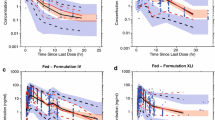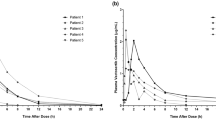Abstract
Purpose
Axitinib, a potent and selective inhibitor of vascular endothelial growth factor receptors, showed antitumor activity as a single agent against several solid tumor types in Phase II and III trials. This study was conducted to evaluate axitinib pharmacokinetics across a variety of solid tumors.
Methods
The current study analyzed the pharmacokinetics of axitinib in 110 patients with non-small cell lung cancer (NSCLC), thyroid cancer, or melanoma from three Phase II trials plus 127 healthy volunteers, using nonlinear mixed-effects modeling. Boxplots of maximum observed plasma concentration (C max) and area under the plasma concentration–time curve (AUC) of data from these tumor populations was compared to C max and AUC from the final population pharmacokinetic model developed for metastatic renal cell carcinoma (mRCC) to compare axitinib pharmacokinetics across different tumor types.
Results
Axitinib disposition based on data from 237 subjects was best described using a two-compartment model with first-order absorption and lag time. Population estimates for systemic clearance, central volume of distribution, absorption rate constant, absolute bioavailability, and lag time were 20.1 L/h, 56.2 L, 1.26/h−1, 0.663, and 0.448 h, respectively. Statistically significant covariates included gender on clearance, and body weight on central volume of distribution. However, predicted changes due to gender and body weight were found not clinically meaningful. The final analysis indicated that the pharmacokinetic model for mRCC was able to successfully describe axitinib pharmacokinetics in patients with NSCLC, thyroid cancer, and melanoma.
Conclusion
The pharmacokinetics of axitinib appears to be similar across a variety of tumor types.





Similar content being viewed by others
References
Hu-Lowe DD, Zou HY, Grazzini ML, Hallin ME, Wickman GR, Amundson K, Chen JH, Rewolinski DA, Yamazaki S, Wu EY, McTigue MA, Murray BW, Kania RS, O’Connor P, Shalinsky DR, Bender SL (2008) Nonclinical antiangiogenesis and antitumor activities of axitinib (AG-013736), an oral, potent, and selective inhibitor of vascular endothelial growth factor receptor tyrosine kinases 1, 2, 3. Clin Cancer Res 14:7272–7283
Choueiri TK (2008) Axitinib, a novel anti-angiogenic drug with promising activity in various solid tumors. Curr Opin Investig Drugs 9:658–671
Kelly RJ, Rixe O (2009) Axitinib–a selective inhibitor of the vascular endothelial growth factor (VEGF) receptor. Target Oncol 4:297–305
Rixe O, Bukowski RM, Michaelson MD, Wilding G, Hudes GR, Bolte O, Motzer RJ, Bycott P, Liau KF, Freddo J, Trask PC, Kim S, Rini BI (2007) Axitinib treatment in patients with cytokine-refractory metastatic renal-cell cancer: a phase II study. Lancet Oncol 8:975–984
Rini BI, Wilding G, Hudes G, Stadler WM, Kim S, Tarazi J, Rosbrook B, Trask PC, Wood L, Dutcher JP (2009) Phase II study of axitinib in sorafenib-refractory metastatic renal cell carcinoma. J Clin Oncol 27:4462–4468
Cohen EE, Rosen LS, Vokes EE, Kies MS, Forastiere AA, Worden FP, Kane MA, Sherman E, Kim S, Bycott P, Tortorici M, Shalinsky DR, Liau KF, Cohen RB (2008) Axitinib is an active treatment for all histologic subtypes of advanced thyroid cancer: results from a phase II study. J Clin Oncol 26:4708–4713
Schiller JH, Larson T, Ou SH, Limentani S, Sandler A, Vokes E, Kim S, Liau K, Bycott P, Olszanski AJ, von Pawel J (2009) Efficacy and safety of axitinib in patients with advanced non-small-cell lung cancer: results from a phase II study. J Clin Oncol 27:3836–3841
Fruehauf JP, Lutzky J, McDermott DF, Brown CK, Meric JB, Rosbrook B, Shalinsky DR, Liau KF, Niethammer AG, Kim S, Rixe O (2011) Multicenter, phase II study of axitinib, a selective second-generation inhibitor of vascular endothelial growth factor receptors 1, 2, 3, in patients with metastatic melanoma. Clin Cancer Res 17:7462–7469
Rini BI, Escudier B, Tomczak P, Kaprin A, Szczylik C, Hutson TE, Michaelson MD, Gorbunova VA, Gore ME, Rusakov IG, Negrier S, Ou Y-C, Castellano D, Lim HY, Uemura H, Tarazi J, Cella D, Chen C, Rosbrook B, Kim S, Motzer RJ (2011) Comparative effectiveness of axitinib versus sorafenib in advanced renal cell carcinoma (AXIS): a randomised phase 3 trial. Lancet 378:1931–1939
Boxenbaum H, Battle M (1995) Effective half-life in clinical pharmacology. J Clin Pharmacol 35:763–766
Rugo HS, Herbst RS, Liu G, Park JW, Kies MS, Steinfeldt HM, Pithavala YK, Reich SD, Freddo JL, Wilding G (2005) Phase I trial of the oral antiangiogenesis agent AG-013736 in patients with advanced solid tumors: pharmacokinetic and clinical results. J Clin Oncol 23:5474–5483
INLYTA (axitinib) prescrining information. http://labeling.pfizer.com/ShowLabeling.aspx?id=759. Accessed July 2, 2014
Pithavala YK, Tortorici M, Toh M, Garrett M, Hee B, Kuruganti U, Ni G, Klamerus KJ (2010) Effect of rifampin on the pharmacokinetics of Axitinib (AG-013736) in Japanese and Caucasian healthy volunteers. Cancer Chemother Pharmacol 65:563–570
Chen Y, Jiang J, Zhang J, Tortorici MA, Pithavala YK, Lu L, Ni G, Hu P (2011) A Phase I study to evaluate the pharmacokinetics of axitinib (AG-13736) in healthy Chinese volunteers. Int J Clin Pharmacol Ther 49:679–687
Pithavala YK, Tong W, Mount J, Rahavendran SV, Garrett M, Hee B, Selaru P, Sarapa N, Klamerus KJ (2012) Effect of ketoconazole on the pharmacokinetics of axitinib in healthy volunteers. Invest New Drugs 30:273–281
Pithavala YK, Chen Y, Toh M, Selaru P, LaBadie RR, Garrett M, Hee B, Mount J, Ni G, Klamerus KJ, Tortorici MA (2012) Evaluation of the effect of food on the pharmacokinetics of axitinib in healthy volunteers. Cancer Chemother Pharmacol 70:103–112
Larson RA, Druker BJ, Guilhot F, O’Brien SG, Riviere GJ, Krahnke T, Gathmann I, Wang Y (2008) Imatinib pharmacokinetics and its correlation with response and safety in chronic-phase chronic myeloid leukemia: a subanalysis of the IRIS study. Blood 111:4022–4028
Houk BE, Bello CL, Poland B, Rosen LS, Demetri GD, Motzer RJ (2010) Relationship between exposure to sunitinib and efficacy and tolerability endpoints in patients with cancer: results of a pharmacokinetic/pharmacodynamic meta-analysis. Cancer Chemother Pharmacol 66:357–371
Garrett M, Poland B, Brennan M, Hee B, Pithavala YK, Amantea MA (2014) Population pharmacokinetic analysis of axitinib in healthy volunteers. Br J Clin Pharmacol 77:480–492
Rini BI, Garrett M, Poland B, Dutcher JP, Rixe O, Wilding G, Stadler WM, Pithavala YK, Kim S, Tarazi J, Motzer RJ (2013) Axitinib in metastatic renal cell carcinoma: results of a pharmacokinetic and pharmacodynamic analysis. J Clin Pharmacol 53:491–504
Lindbom L, Pihlgren P, Jonsson EN (2005) PsN-Toolkit–a collection of computer intensive statistical methods for non-linear mixed effect modeling using NONMEM. Comput Methods Programs Biomed 79:241–257
Hooker AC, Staatz CE, Karlsson MO (2007) Conditional weighted residuals (CWRES): a model diagnostic for the FOCE method. Pharm Res 24:2187–2197
Savic RM, Karlsson MO (2009) Importance of shrinkage in empirical bayes estimates for diagnostics: problems and solutions. AAPS J 11:558–569
Garrett M, Amantea MA, Pithavala YK, Ruiz A (2010) Evaluation of the impact of omitting drug concentration data below the lower limit of quantification (LLOQ) on the pharmacokinetics of axitinib (AG-013736), an anti-angiogenic agent. Clin Pharmacol Thera 87(suppl 1; abstr PIII-33):S78–S79
Karlsson MO, Savic RM (2007) Diagnosing model diagnostics. Clin Pharmacol Ther 82:17–20
Houk BE, Bello CL, Kang D, Amantea M (2009) A population pharmacokinetic meta-analysis of sunitinib malate (SU11248) and its primary metabolite (SU12662) in healthy volunteers and oncology patients. Clin Cancer Res 15:2497–2506
Jain L, Woo S, Gardner ER, Dahut WL, Kohn EC, Kummar S, Mould DR, Giaccone G, Yarchoan R, Venitz J, Figg WD (2011) Population pharmacokinetic analysis of sorafenib in patients with solid tumours. Br J Clin Pharmacol 72:294–305
Tortorici MA, Toh M, Rahavendran SV, LaBadie RR, Alvey CW, Marbury T, Fuentes E, Green M, Ni G, Hee B, Pithavala YK (2011) Influence of mild and moderate hepatic impairment on axitinib pharmacokinetics. Invest New Drugs 29:1370–1380
Smith BJ, Pithavala Y, Bu H, Kang P, Hee B, Deese AJ, Pool WF, Klamerus KJ, Wu EY, Dalvie DK (2014) Pharmacokinetics, metabolism, and excretion of [14C]axitinib, a vascular endothelial growth factor receptor tyrosine kinase inhibitor, in humans. Drug Metab Dispos 42:918–931
Lamba JK, Lin YS, Schuetz EG, Thummel KE (2002) Genetic contribution to variable human CYP3A-mediated metabolism. Adv Drug Deliv Rev 54:1271–1294
Zhao W, Elie V, Roussey G, Brochard K, Niaudet P, Leroy V, Loirat C, Cochat P, Cloarec S, Andre JL, Garaix F, Bensman A, Fakhoury M, Jacqz-Aigrain E (2009) Population pharmacokinetics and pharmacogenetics of tacrolimus in de novo pediatric kidney transplant recipients. Clin Pharmacol Ther 86:609–618
Han JY, Lim HS, Shin ES, Yoo YK, Park YH, Lee JE, Jang IJ, Lee DH, Lee JS (2006) Comprehensive analysis of UGT1A polymorphisms predictive for pharmacokinetics and treatment outcome in patients with non-small-cell lung cancer treated with irinotecan and cisplatin. J Clin Oncol 24:2237–2244
Brennan M, Williams JA, Chen Y, Tortorici M, Pithavala Y, Liu YC (2012) Meta-analysis of contribution of genetic polymorphisms in drug-metabolizing enzymes or transporters to axitinib pharmacokinetics. Eur J Clin Pharmacol 68:645–655
Acknowledgments
This study was sponsored by Pfizer Inc. Medical writing support was provided by Mariko Nagashima, PhD, at Engage Scientific Solutions (Southport, CT, USA) and was funded by Pfizer Inc.
Conflict of interest
The current study and trials included in the analyses were funded by Pfizer Inc. Yazdi K. Pithavala and Ana Ruiz-Garcia are employees of and own stock in Pfizer Inc. Michael A. Tortorici, May Garrett, and Sinil Kim were employed at Pfizer Inc during the time of this study and development of the manuscript. Michael A. Tortorici is currently an employee of CSL Behring Biotherapies for Life™ and owns stock in Pfizer Inc. May Garrett is currently a contracted employee of and owns stock in Pfizer Inc. Sinil Kim is currently an employee of Mirna Therapeutics and owns stock in Pfizer Inc and Mirna Therapeutics Inc. Ezra E.W. Cohen has nothing to disclose. John P. Fruehauf received research funding from Pfizer Inc.
Author information
Authors and Affiliations
Corresponding author
Additional information
Michael A. Tortorici, May Garrett, and Sinil Kim were employed at Pfizer Inc during the time of this study and development of the manuscript.
Electronic supplementary material
Below is the link to the electronic supplementary material.
Rights and permissions
About this article
Cite this article
Tortorici, M.A., Cohen, E.E.W., Pithavala, Y.K. et al. Pharmacokinetics of single-agent axitinib across multiple solid tumor types. Cancer Chemother Pharmacol 74, 1279–1289 (2014). https://doi.org/10.1007/s00280-014-2606-6
Received:
Accepted:
Published:
Issue Date:
DOI: https://doi.org/10.1007/s00280-014-2606-6




